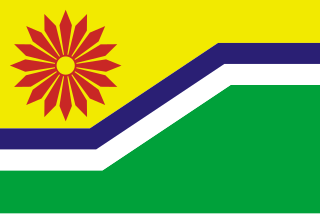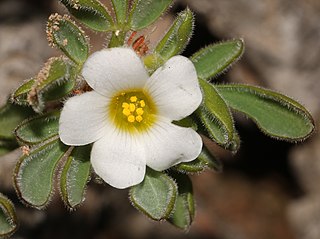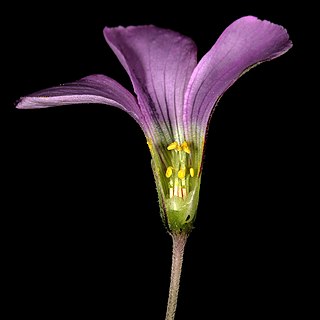
Mpumalanga is one of the nine provinces of South Africa. The name means "East", or literally "The Place Where the Sun Rises" in the Nguni languages. Mpumalanga lies in eastern South Africa, bordering Eswatini and Mozambique. It shares borders with the South African provinces of Limpopo to the north, Gauteng to the west, the Free State to the southwest, and KwaZulu-Natal to the south. The capital is Mbombela.

Kirstenbosch is an important botanical garden nestled at the eastern foot of Table Mountain in Cape Town. The garden is one of 10 National Botanical Gardens covering five of South Africa's six different biomes and administered by the South African National Biodiversity Institute (SANBI). Prior to 1 September 2004, the institute was known as the National Botanical Institute.

Othonna is a genus of approximately 90 species of succulent or subsucculent perennial herbs or shrubs, with its center of diversity in the Greater Cape Floristic Region (GCFR) of South Africa but some species' ranges include southern Namibia, Angola, and Zimbabwe. The genus was established by Linnaeus in 1753 containing 14 species, however, of those original species, only four are still retained in Othonna, while the others have been transferred to different genera including Cineraria, Euryops, Hertia, Ligularia, Senecio, and Tephroseris. The genus Othonnna is known to be monophyletic. In 2012, a new genus Crassothonna B. Nord. was erected with 13 species transferred from Othonna. A complete modern taxonomic treatment of the genus is being undertaken by the Compton Herbarium and the South African National Biodiversity Institute. The first part, a revision of the Othonnna bulbosa group, was published in 2019.

Bulbine frutescens, the wild kopieva or stalked bulbine, is a species of flowering plant in the genus Bulbine, native to southern Africa.

Aloiampelos ciliaris, the common climbing-aloe, is a thin-leaved and generally rapidly-growing succulent plant from Southern Africa.

iNaturalist is an American 501(c)(3) nonprofit social network of naturalists, citizen scientists, and biologists built on the concept of mapping and sharing observations of biodiversity across the globe. iNaturalist may be accessed via its website or from its mobile applications. iNaturalist includes an automated species identification tool, and users further assist each other in identifying organisms from photographs. As of 9 July 2024, iNaturalist users had contributed approximately 197,660,888 observations of plants, animals, fungi, and other organisms worldwide, and 290,007 users were active in the previous 30 days.

iSpot is a website developed and hosted by the Open University with funding from the Open Air Laboratories (OPAL) network with an online community intended to connect nature enthusiasts of all levels.
The South African National Biodiversity Institute (SANBI) is an organisation tasked with research and dissemination of information on biodiversity, and legally mandated to contribute to the management of the country's biodiversity resources.
Graham Dugald Duncan is a South African botanist and specialist bulb horticulturalist at the Kirstenbosch National Botanical Garden, Cape Town, South Africa.

SeaKeys is a large collaborative marine biodiversity project funded through the Foundational Biodiversity Information Program in South Africa. The purpose of the project is to collect and distribute genetic, species and ecosystem information relating to marine biodiversity in southern Africa, which may be used to support informed decision-making about the marine environment.

Oxalis virginea, commonly known as Virgin sorrel, is a species from the genus Oxalis. It is endemic to South Africa. O. virginea was first described by Nikolaus Joseph von Jacquin in 1798. This species is apparently lacking a type specimen.

Oxalis bifida is a species of plant. The species was originally described by Carl Peter Thunberg in 1794

Psoralea cataracta is a species of flowering plant in the family Fabaceae. It was declared extinct in 2008 in the Red List of South African Plants, with a single specimen collected from the Tulbagh Waterfall in 1804. It was rediscovered 200 years later by Brian Du Preez in November of 2019 in the Winterhoek Mountains near Tulbagh. It is endemic to the Western Cape. It is also known by the name waterfall fountainbush.

Aspalathus cordicarpa is a species of flowering plant in the family Fabaceae. Prior to its rediscovery in 2016, Aspalathus cordicarpa was last collected in 1950 and thought to be extinct. It is endemic to the Fynbos region around Garcia's Pass in the Western Cape. It is also known as the Heartfruit Capegorse.

Bulbine favosa is a species of tuberous, geophytic plant in the genus Bulbine, which grows in sandy soils in South Africa.

Geissorhiza splendidissima, the blue pride-of-Nieuwoudtville, is a plant species of geophyte in the family Iridaceae. It is endemic to Nieuwoudtville in the Northern Cape of South Africa. It is also called the Bokkeveld pride and splendid satin.

Nemesia versicolor is a species of perennial flowering plant in the family Scrophulariaceae. It is endemic to the Northern and Western Cape Provinces of South Africa.

Aloe mutabilis, commonly known as the blue krantz aloe is a species of aloe endemic to northern South Africa.

Agapanthus caulescens, the stem agapanthus, is a species of flowering plant in the family Amaryllidaceae. Its three subspecies are found in Eswatini and eastern South Africa.

Agapanthus campanulatus, the bell agapanthus, is a species of flowering plant in the family Amaryllidaceae endemic to the Drakensberg in Southern Africa.

















